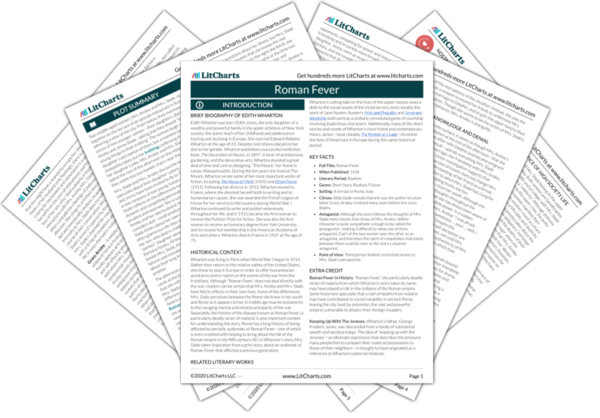Even before their conversation turns to the romantic dramas of their youth, Mrs. Ansley and Mrs. Slade are each concerned with the past. The symbols of ancient Rome that provide the backdrop for their afternoon—the Forum, the Colosseum, and the Palatine Hill—evoke an atmosphere of faded splendor, and Mrs. Slade’s rapturous comments about the view reveal her longing to exchange her difficult present for a simpler and more satisfying past.
Mrs. Slade’s longing for the past is, at least in part, a reflection of the anxieties that accompany the major life transition in which she has found herself. Mrs. Ansley and Mrs. Slade are both recent widows. Mrs. Slade notes how the deaths of their husbands during the same short period of time cause the two women to resume their friendship after a long stagnation. Although she does not talk about the loss of her husband, and limits even her private thoughts to glib remarks about the “dullish business” of widowhood, it is clear that widowhood is difficult for Mrs. Slade. The fact that her grown daughter, Jenny, is approaching a point where she will marry and begin a family of her own adds to her feelings of loneliness and frustration. Mrs. Ansley, by contrast—who speaks relatively little and whose inner thoughts are mostly inaccessible to the reader—seems content on the surface. However, she reveals her frustration and sadness in subtle ways. She makes a remark that it is the “collective modern idea of Mothers,” rather than anything specific about herself and Mrs. Slade, that leads Barbara to joke about the two older women knitting while she and Jenny escape on a romantic adventure. Mrs. Ansley’s remark reveals her own sense that she is becoming obsolete.
Despite her rueful comments about her own irrelevance, Mrs. Ansley’s attitude toward the past presents a marked contrast to that of Mrs. Slade. Unlike her friend, Mrs. Ansley seems comfortable with her memories, and is not attached to an overly romantic view of the past. She does not appear sentimental about her memories of Rome—as Mrs. Slade observes, she is able to knit calmly even while gazing at the beautiful view of the city—but she still acknowledges the power of those memories when she agrees that it is “the most beautiful view in the world” and “always will be.” Her more measured response seems to suggest that she is at peace, content with her decisions and not burdened by the same feelings of hatred and jealousy that Mrs. Slade has harbored for decades. This may be because Mrs. Ansley never had the luxury of denying her past: her daughter, Barbara, presented a daily reminder of her affair with Delphin and its impact on her life. Therefore, she arguably has a fuller and more mature understanding of her life than Mrs. Slade, and so is not attached to a nostalgic ideal.
Nostalgia ThemeTracker

Nostalgia Quotes in Roman Fever
As they leaned there a girlish voice echoed up gaily from the stairs leading to the court below. “Well, come along, then,” it cried, not to them but to an invisible companion, “and let’s leave the young things to their knitting … After all, we haven’t left our poor parents much else to do.”
“Moonlight—moonlight! What a part it still plays. Do you suppose they’re as sentimental as we were?”
“I’ve come to the conclusion that I don’t in the least know what they are,” said Mrs. Ansley. “And perhaps we didn’t know much more about each other.”
In living up to such a husband all her faculties had been engaged; now she had only her daughter to live up to, for the son who seemed to have inherited his father’s gifts had died suddenly in boyhood. She had fought through that agony because her husband was there, to be helped and to help; now, after the father’s death, the thought of the boy had become unbearable. There was nothing left but to mother her daughter; and dear Jenny was such a perfect daughter that she needed no excessive mothering … She wished that Jenny would fall in love—with the wrong man, even; that she might have to be watched, out-manoeuvred, rescued.
Mrs. Ansley had resumed her knitting. One might almost have imagined (if one had known her less well, Mrs. Slade reflected) that, for her also, too many memories rose from the lengthening shadows of those august ruins. But no; she was simply absorbed in her work.











